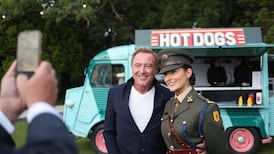In Solo, the new James Bond novel, the spy observes a beautiful woman wearing a catsuit as they both occupy a slowly descending lift in the Dorchester Hotel, before he settles down, alone, to a large breakfast.
There is much about food and drink in Solo, written by William Boyd. It is set in 1969, and begins with Bond staying in the Park Lane hotel celebrating – alone – his 45th birthday over a dinner of pan-fried scallops with a beurre blanc sauce, followed by fillet of beef, rare, with pommes dauphinoises.
The meal in the hotel’s dining room, preceded by a couple of dry martinis in Fieldings’ private casino, is washed down with a Taittinger rosé 1960, followed by a Château Batailley 1959 to accompany his main course.
In reality, for the launch of the book, the Dorchester fare is less plentiful: juice, coffee and a boiled egg (to be eaten standing up), surrounded by TV cameras and a bevy of young women wearing 1960s-style air- hostess uniforms, waiting for the launch of the latest work.
“There is a lot of eating and drinking in it. There is a lot of interest in clothes, Bond is a sensuous man. There is also a lot about automobiles and weaponry and, of course, two beautiful women he has relations with.
“It wouldn’t be a Bond novel without those things in it,” the author tells journalists gathered for the launch, the first of a series to take place this week around the world.
Between 1952 and his death in 1964, the spy's creator, Ian Fleming, wrote 14 novels, beginning with Casino Royale. The author's demise – accelerated by heavy smoking – was in Sandwich in Kent, far from his Goldeneye paradise retreat in Jamaica.
Boyd is the latest in a long line of writers to take up the Bond mantle. “When invited I didn’t hesitate, I accepted at once. For me, the prospect appeared incredibly exciting and stimulating,” Boyd says.
Time has brought its own connections. If Boyd is now adopting the Fleming role, it repays a decade-old compliment when he included the one-time naval intelligence officer as a character in one of his own novels.
Fleming looms large
Equally, he has brought some of Fleming's own life into the book, by making Bond a member of the Royal Commando's 30 AU unit – the same one Fleming set up in the second World War to capture German intelligence records and equipment after the D-Day landings.
In preparing to write the book, Boyd avoided the films that have defined Bond for millions, instead preferring to read each of Fleming’s works – filled with violence and a heady undercurrent of sex, along with a strong strain of misogyny – in chronological order.
"I came to admire what he had done in the Bond novels as a writer," says Boyd, who remembers reading the first of Fleming's works as a young boy in Gordonstoun prep school in Scotland after lights-out "as a kind of illicit thrill".
Having taken the Fleming model and structure, Boyd says he has filtered it through his own imagination, adding a few quirky touches, such as his own recipes for a dry martini or a precisely made vinaigrette.
Instructed by a childhood in Africa, where heavy drinking and smoking were the norm, Boyd says he did not “sanitise” the Bond story for a modern-day audience that is perhaps less used to endless accounts of both.
“My father used to come home from his clinic at lunchtime and have two very large pink gins before lunch. I didn’t think that there was anything out-of-the-ordinary about that, and then he would drink whiskey in the evening.”
Bond's boozy side
Creating his Bond, he thought about the cigarettes that Bond would smoke, the cars that he would drive. "You think about what whiskey would Bond like drinking: Dimple Haig. Now I don't know if that brand still exists, but I remember it in shops in Africa."
The misogyny and racism that marks Fleming’s works – particularly the early ones – were, says Boyd, “very reflective of the kind of unthinking attitudes of a man of his class, background and education.
“One of the advantages of setting the novel in 1969 is that there was a massive shift in attitudes that took place around the mid-1960s,” he says, “so an intelligent man like Bond, even if born pre-war, could not be unaware of the way in which society was changing.
“Old attitudes were out of date. I haven’t set out to make Bond ultra-modern, but there is no doubt but that he is aware that the world has changed,” says Boyd, who remembers London in 1969 because it was the year he first visited the city.
When asked about his favourite Bond actor, Boyd bats the question away, before seeming to change his mind.
“I think Daniel Day-Lewis resembles the Bond that Fleming described. On three occasions, he describes Bond looking like the American songwriter Hoagy Carmichael – a tall, rangy, very dark-haired, good-looking man, almost swarthy. This is what he saw his Bond looking like.”













